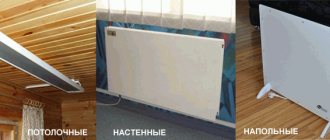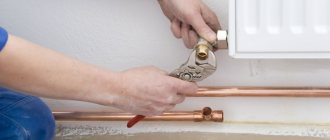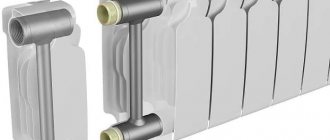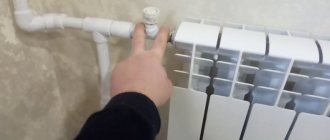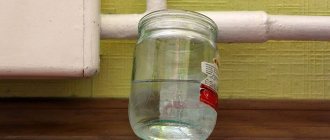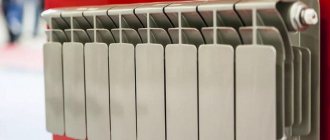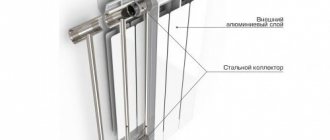Many people have found themselves in a situation where the heating radiator does not heat up or the heating is insufficient. There are few reasons for poor radiator heating, but in each case they are eliminated differently.
The heating system comes in two types: one-pipe, the so-called Leningradka, and two-pipe. In apartment buildings, single-pipe is predominantly used. The vast majority of individual properties and recent new buildings use a two-pipe system.
In a single-pipe system, the coolant enters a single riser, from where it is distributed to the radiators. Supply is carried out from the first or last floor, which is not of fundamental importance. Bypasses are used to ensure uniform water supply to all batteries. Thanks to them, the required amount of water enters the radiator, the rest moves to the next sections. The disadvantage of a one-pipe system is that batteries that are located closer to the inlet or boiler warm up better. The furthest ones in the system may not warm up enough.
Two-pipe heating system
In a two-pipe system, each radiator is independently connected to two risers. Hot water is supplied from one, cooled water goes to the other. Ignorance of the features of heating systems of various types sometimes leads to dire consequences, especially when unskilled workers are involved in repairs.
Infrequently, but there are cases when old batteries in a single-pipe system are replaced with modern aluminum ones. The expected effect does not occur, because aluminum appliances are designed for a two-pipe system, the coolant current weakens. Moreover, due to poor water circulation, they become clogged. There is only one way out - to repair old batteries or install new ones suitable for a single-pipe system.
There are two main reasons why batteries do not heat up - air lock and clogged radiators. The air lock interferes with the circulation of the coolant, the radiator does not warm up well or remains cold. The way out of the situation is simple - remove the air.
Modern systems have a special tap at the top of each battery for bleeding air. It is turned with a screwdriver or adapter. If there is air in the system, you will hear a hissing sound. The tap is kept open for some time until coolant flows out of it. If the air lock is very large, it may not be possible to completely bleed the air at one time. Wait ten minutes and try again until you feel the battery warming up completely.
Air bleed valve
Do not release a lot of coolant, hoping to remove air along with it. This threatens a loss of pressure and possible shutdown of the boiler in a private home.
On cast iron radiators that have been installed for a long time, there is most likely no air bleed valve. The simple job of bleeding the air turns into a complex and dirty one. There are two approaches to removing air from a cast iron battery. The first is through the coupling on the coolant supply to the radiator, the second is by loosening the plug in the battery. In each case, it is not necessary to completely unscrew the coupling or plug; they are turned a little until a hiss appears.
It is important to determine in which direction the coupling or plug should be unscrewed, because radiators use both right-hand and left-hand threads. Where the coupling turns is determined by the protruding part of the thread. The letter “L” is stamped on the plug with a left-hand thread; turn it to the right. It is important not to overdo it, especially when unscrewing the coupling, because the pipes can be rusty and can collapse from excessive force. Just in case, before screwing, wrap a little tow with paint or fumlenta onto the threads so that water does not seep through the broken connection.
Clogged radiators are the main cause of poor heat supply
Clogged radiators are the second common cause of poor heat supply. The system becomes clogged for two reasons: physical wear due to long-term use or the supply of dirty water to the system without filtration. More often than not, salts have been deposited on the inner walls for many years and the system becomes clogged. Sometimes the deposits are so thick that the coolant is completely unable to get through the narrow cracks. There is only one way out - replacing the radiators, and sometimes also the pipes.
Do not drain water unless absolutely necessary. Each dose of fresh water adds sediment and clogs the system.
If the clogging is minor, the batteries are washed. It is better to carry out work when the heating is not working. If you have to resort to such an operation during the heating season. Then disconnect the batteries by turning the taps and remove. Not all systems have valves to turn off radiators. Before cleaning the system, water is drained in individual properties; in a multi-story building, the supply is shut off. During the heating season, be careful - the water is very hot.
Clean the battery under high pressure. To do this, take the batteries outside, tightly connect the battery with a water source with a hose and blow it out. Rinsing with water from the tap will not work; some of the debris will still remain in the radiator. If a blockage is found in one battery, flush the others as well; they are almost certainly clogged too.
In the private sector, in addition to the above reasons for unsatisfactory heating performance, there are others. Private houses have almost 100 percent autonomous heating. The cause of poor heating may be the heating boiler. Most likely, the boiler power is calculated incorrectly; it is not enough to heat the coolant to an acceptable temperature. If the automatic boiler does not turn off, this is a sure sign of insufficient power.
Properly equipped boiler room
If the boiler is running, the liquid will still warm up. When the radiators are completely cold, the heating unit is broken or does not turn on. Modern boilers turn on when the minimum pressure level in the system is observed. The boiler will not turn on if it is less. Also, modern boilers are equipped with a security system. For example, in a gas boiler there is a sensor that is responsible for ensuring that exhaust gases go into the chimney. If for some reason the smoke does not go away completely, the automation will work, the boiler will turn off and will not turn on until the problems are corrected.
What other reasons are there why the battery in the house does not heat? The pressure in the system may be too low and, as a result, circulation is disrupted. If the batteries are old, this reason is unlikely, because two atmospheres (the usual pressure of a home system) is enough for them. But some modern batteries require higher pressure. Before installing them, it is worth looking at the passport to see if the system can create the required pressure.
You can slightly increase the pressure in the system by installing a circulation pump with an appropriate system capacity.
Since heating in private homes is often done by people who are illiterate in this regard, installation errors are possible, causing the heating to be weak. It is believed that the use of a single-pipe system saves pipes, but due to the peculiarities of the system, the heating of the batteries weakens as they move away from the boiler or they remain completely cold. In addition, batteries remote from the boiler should have more sections. It's impossible to save money.
The main reasons for this phenomenon
The problem of “cold bottom” (let’s call it that) is faced not only by those whose system is equipped with fairly old heat exchangers, but also by people who have installed bimetallic heating radiators. There are many reasons why this problem occurs, so it is difficult to immediately say why the batteries do not warm up evenly enough. Typically, each specific case should be considered individually. So, let's try to figure out the main reasons for this malfunction.
Reason #1. Normal blockage
The very first (because the most common) reason for this phenomenon is contamination of heating radiators. Here are the main reasons for the temperature decrease in the lower part of the device:
- low-quality coolant is used;
- air has entered the system.
It is worth noting that the working fluid can contain not only heat, but also various solid particles. For example, when the heating season begins, and centralized lines are just starting up, the quality of the working fluid is, to put it mildly, disgusting. Things are much better in the case of an individual heating circuit - contamination can penetrate into it only through an open expansion chamber.
This is all clear, but how can the temperature difference be affected by the presence of air in the system? The explanation for this is very unusual - bacteria are to blame. There is a certain variety of such microorganisms that can exist only in the presence of a sufficient amount of oxygen. Such bacteria are known as anaerobic. There is nothing wrong with them, but their waste products settle at the bottom of the heating radiator in the form of sediment.
Note! It is also worth noting that the working fluid brings sludge into the battery from almost the entire heating line, and it settles there.
Finally, another reason that the bottom of the battery is cold and the top is hot can be considered the special design of the heat exchanger. The liquid moves in it, permanently changing the vector of its own motion. And inside the heat exchanger there is a fairly large number of “secluded places” in which dirt can be deposited.
Video - Cleaning the heating radiator
This reason is more or less clear, so let’s move on to the next one.
Reason #2. Problems with shut-off valves
Sometimes the reason why the temperature of the lower part of the radiator is lower than the upper part can be due to the shut-off valves. In previous articles we have already examined the design features of such reinforcement, so today we will only briefly consider a few main points. The main purpose of shut-off valves in the heating circuit is to regulate, as well as completely/partially block the movement of the working fluid.
The fittings can be the following mechanisms.
- Ball valve.
- Thermal head, which is equipped with mechanical or electronic control.
- Cone valve.
But what does the decrease in temperature at the bottom of the radiator have to do with it, you ask? The fact is that as a result of problems with shut-off valves, the circulation of the working fluid inside the heat exchanger is disrupted. After all, the tap may simply become unusable, which is why the coolant will not flow even in its open position. This, for example, could be a failed damper or any other mechanism failure. It is also worth adding that the correct installation of shut-off valves also plays a very important role in this case.
Note! All taps of this type have an arrow indicating in which direction the working fluid must move in order for the heating line to function normally.
And if the tap is installed incorrectly, then one way or another the movement of the coolant will be disrupted: in this case, it will not matter whether the damper mentioned above is closed or open. We also note that for some types of shut-off valves there are requirements regarding the position in which the valve itself should be located relative to the space. For this reason, in case of problems with the uniform heating of heating devices, the shut-off valves should also be inspected.
What to do if bimetallic batteries do not heat up?
If during the heating season the apartment is not warm enough, then viral and cold diseases appear. Let's consider in what case bimetallic batteries do not heat up and what are the reasons?
First, make sure that the room temperature is below the established standards, which are as follows:
- If the room is located on the ground floor, then it should warm up to +20°C, and in the living room up to +18°C;
- The kitchen should warm up to +18°C;
- Bath up to +25°C;
- Corner room up to +20°C;
- At the entrance, on the staircase it should be up to +16°C;
- In the attic and basement up to +4°C;
- In the elevator up to +5°C.
How to correctly measure the room temperature?
In each room, measurements are taken at a distance of 100 cm from the inner wall, and it should be 150 cm from the floor. If they do not meet the above requirements, then there may be the following reasons:
- Debris has accumulated in the radiator;
- Air has collected in the system.
Radiators are dirty
First, check the pipes. If they are hot, then talk to your neighbors, if they heat up normally, then the reason is your radiators, which are clogged with dirt (metal oxide or other debris that does not allow the coolant to circulate freely). If you touch the top of the battery and feel that it is hot and cold at the bottom, then debris and dirt are located at the bottom. In this case, warm up the radiator from below, the coolant will heat up and begin to move through the system, and possibly dirt will leave with it.
It is quite difficult to clean dirty heating devices on your own, and therefore it is better to contact specialists who will clean them quickly and efficiently.
There is air in the radiator
It is important! Even if the heating radiators are new, and therefore not clogged with debris and dirt, then they have accumulated air, which can be removed independently. Each device has a tap, and by opening it you can drain the water, which will release air and cause the batteries to heat up.
The taps can also be installed on the riser. If a regular tap is installed, then you can simply open it, but if a Mayevsky tap is installed, then it is automatic and to open it you need to unscrew the cap and press the valve to drain the water, but before that you need to place a vessel under the heating device.
Next, close the tap and the radiator begins to heat up.
If you live in a private house and the bimetallic batteries do not heat well, then check each of the installed radiators and, if necessary, open the Mayevsky tap and drain the water.
Installation
Let's consider the existing types of connecting a heating battery to the system, which can be:
- Lateral;
- Nizhny;
- Diagonal.
With a lateral (one-sided) connection, the taps enter the radiator from the side, which ensures that the battery operates at maximum power, and if necessary, the heater can be easily replaced. If the length of the heating unit exceeds 160 cm, then a diagonal connection is used.
When the battery is connected to the bottom side, 90% of the total power of the heater is used. But such a connection is used extremely rarely, only in the case of baseboard wiring.
The bottom connection is used only when connecting to the heating system those heating devices that are designed specifically for this type of connection.
The diagonal connection to the system also ensures high-quality operation of the radiators, with the inlet pipe connected on one side from the top, and the outlet pipe on the opposite side from the bottom. This type is considered the best.
What do installation errors lead to?
If the radiators are not connected correctly, then the water is supplied not from above, but from below, and therefore it passes below and does not warm up the entire heating device. In this case, a coolant flow extension can help.
If the first few sections of the radiator are warming up and the owner is tormented by the question: - why doesn’t the bimetallic battery heat up? - the answer can be given by plumbers who will make calculations and correct all the shortcomings made during the installation of the system.
In order for the heating device to work properly and warm up the entire room efficiently, it is necessary to pay attention to the number of sections in a single unit, which should not be more than 12 (if the system is gravitational), and if it is circulation, then the number of sections should be from 20 to 24 knots. If there are more compartments, then the heater will not heat well.
If the diameter of the pipes for supplying the coolant is incorrectly selected, uneven heating of the batteries is also possible. For example, if the cross section is small, then the pressure is insignificant and is not enough to heat the system. To correct such an installation error, it is necessary to replace the pipes with the required diameter.
In order to increase the heat transfer of the heating device, it is necessary to keep it clean, and attach reflective material (foil can be used) to the wall behind it and paint the battery in a dark color (it emits thermal energy better).
Today it has become fashionable to install a heating battery with a thermostat in an apartment of a multi-storey or country house, but you don’t have to install a bypass pipe, but to do this, talk to representatives of the housing department.
Conclusion
For high-quality operation of the heating system, it is necessary to make the right choice when purchasing a heating device. How to connect a bimetallic battery to the utility network, or rather which connection method to use, is up to the owner of the apartment and the type of unit chosen.
In order for radiators to work well and heat the entire area, it is necessary to carry out high-quality installation in compliance with all requirements and recommendations. If this work cannot be carried out independently, you should contact specialists for help, who will quickly and with a quality mark install the heating system.
Source: https://santehkrug.ru/chto-delat-esli-ne-greyut-bimetallicheskie-batarei.html
New bimetallic radiators have a cold bottom while the top is hot: possible reasons
As already noted, for all models the heating of the lower region is weaker than that of the upper. This is explained by the high heat transfer of the bimetal - the water has time to cool thoroughly during the passage. Hence the temperature difference, which worries owners so much.
When not to worry
But with such insignificant differences there should be no reason for concern - this is a normal situation, given the features of this type of device:
- A single vertical channel in each section (for example, cast iron products have two).
- Small channel diameter (little coolant), but effective heat transfer due to the special configuration of the fins.
- Profiled convection channels between the ribs of the sections contribute to enhanced heat transfer, regardless of whether the battery is made by Italian or Russian.
- The thin walls of the sections heat up quickly, but also cool down just as quickly. Therefore, if you have bimetallic radiators at home and the bottom is cold and the top is hot near the appliances, this property needs to be taken into account.
Probable causes of uneven heat transfer
Despite similar trends, each case must be considered individually. If we ignore three important factors: incorrect calculation of the power of the boiler, pump and number of batteries, then we should take into account the likelihood of the following problems:
- Air jams are an inevitable consequence of measures to fill the structure with coolant. An additional symptom is gurgling or hissing sounds. The solution is the installation of a Mayevsky crane.
- Clogging of heating appliances is the result of neglecting regular flushing of the system, especially in apartments with a central heating system.
- Unsatisfactory coolant circulation - if distant heating units do not heat up well, then it is worth considering this reason, in particular in systems with natural circulation. To solve the problem when bimetallic radiators are hot at the top and too cold at the bottom, installing a circulation pump will help.
- Incorrect operation of the heating structure is a fairly common factor when the bypass is not adjusted. Even experienced home craftsmen who know how to properly install a battery with their own hands make mistakes when performing commissioning work.
- Problems with shut-off valves - proper installation of these units does not guarantee that over time the mechanism or electronic components will not fail.
Air jams
A common reason for poor heating of a bimetallic battery is airing of the system, which is associated with the accumulation of air bubbles inside the radiator. To avoid the formation of an air lock, a Mayevsky valve is installed on the line, which allows air to be periodically released manually or automatically. To activate the release of air masses, the manual valve is opened with a key or a screwdriver. Automatic models are equipped with a float, which automatically lowers when air accumulates and allows it to escape to the outside.
Useful tips
When starting the stage of restoring heating efficiency, you need to analyze the situation and determine the cause of the problem. The course of action is as follows:
- Check the correctness of communications.
- Check for air in the system and, if present, release it.
- Inspect the heating device and clean the internal cavity.
- Assess the functional condition of shut-off valves and control valves.
- Determine the performance of the system, if necessary, change or install a more powerful pump.
If you find a situation where the bimetallic radiators are very hot at the top and cold at the bottom, it is worth checking the control valves (if any are provided for in the project). It is necessary to immediately remove such a unit and conduct a detailed inspection. If deposits are found that narrow the cross-section, they should be removed. However, the best option would be to replace the part with a new one.
Low system pressure also does not contribute to efficient heat transfer. This may be due to the pump, or its absolute absence. Therefore, it is not without reason that experts advise installing modern equipment. This is the only way to obtain high-quality heat supply.
Radiator clogged
Often the problem of poor-quality heating is associated with contaminated coolant, which may contain rust, sand and other impurities. Under the influence of high temperatures, they form a coating on the inner surface of the radiator, which prevents normal water circulation. Plaque is able to absorb heat and reduce the volume of coolant passing through the system, so the battery begins to cool.
The way out of the situation is to clean the line, which can be done in various ways:
- mechanical;
- chemical;
- hydrodynamic;
- hydropneumatic.
The easiest way to flush is with special chemicals that can break down deposits and wash away dirt. To avoid this problem again, preventative cleaning should be performed annually, and general cleaning every 5-7 years.
Why and why heating radiators do not heat up and how to fix it
In fact, there may be several reasons why heating radiators do not heat, so it is necessary to understand the situation in each individual case. Qualified assistance may be required to resolve the problem. You can achieve uniform heating of radiators yourself.
What are the reasons for radiators not fully warming up?
There are several common reasons for uneven heating of radiators. To troubleshoot the problem, you need to understand what exactly led to the existing violations.
- The last radiator in the heating system does not heat up - the reason is insufficient power of the circulation pump, non-observance of angles and slopes when installing the pipeline.
- The lower part of the heating radiator does not warm up completely - this problem is usually typical for aluminum heating radiators. In some cases, the cause is an incorrectly set mode of the thermostat installed on the coolant supply to the battery.
- Half of the radiator does not give off heat - a cold top indicates the presence of an air lock. If the outer sections are cold, this indicates an identical problem.
- The lower corner of the heating radiator is cold - errors made during installation. Bimetallic and aluminum batteries must be installed perfectly level. Distortions lead to uneven heating of sections.
Need to fix the problem
If the heating season has already begun, and utility services do not want to provide heat to apartments, then you need to try to solve this problem. It also happens that at the height of the heating season the batteries remain barely warm, then consumers of central heating services begin to decide where to turn.
Experienced lawyers recommend starting to call the appropriate authorities. Utility workers must respond to problems that are expressed in completely cold radiators. In this case, the pipes may be hot. Consumer requests must also be responded to in cases where the radiator is only partially warmed up. One heating element may remain cold while all the others may be hot.
Before contacting the appropriate services, you should familiarize yourself with the temperature conditions in heated rooms prescribed in the regulatory documentation.
Low coolant speed
Insufficient coolant velocity directly depends on the design of the heating system, the characteristics of the coolant, the power and performance of circulation pumping equipment, pipe material and diameter.
Optimal indicators:
- private households and apartments - 0.5-1.5 m/sec;
- production premises - within 3 m/sec.;
- administrative buildings - within 2 m/sec.
The speed of movement of the coolant in pipeline heating systems is taken in accordance with the permissible equivalent sound level in rooms for various purposes. When the power of the pumping equipment is reduced, the movement of the coolant slows down, which has time to cool down and the last radiators warm up worse. As a special case, the bottom can be cold and the top of the radiators hot. In this case, it is necessary to increase the power indicators of the device, which will ensure not only faster circulation, but also the most uniform heating of the radiators.
Don't miss: DIY waste oil heat gun
What are the consequences of inefficient operation of heating devices?
A certain part of homeowners believe that if bimetallic radiators are hot at the top and cold at the bottom, then there is no need to worry too much - it will somehow get better. In reality, this problem causes a lot of inconvenience, which may ultimately result in serious repairs:
- The efficiency of heating appliances decreases.
- Reducing the room temperature.
- Adjusting additional reinforcement does not correct the situation.
Important! Do not forget that a small temperature difference between the top and bottom of the batteries is not a significant indicator of malfunction. Another thing is a significant difference in heating; it negatively affects the heating efficiency.
The shut-off valve is broken
Shut-off type fittings are intended to completely or partially shut off the supply of coolant to the heating network. The main components of such fittings are presented:
- valves;
- ball valves;
- thermal heads with mechanical or automatic adjustment.
The lower part of the battery does not warm up, but the upper part becomes hot due to malfunctions inside the faucet. As a rule, problems are caused by a broken valve or any other disturbance that prevents the correct functioning of the element, as well as the unimpeded circulation of heated liquid.
Self-installation of fittings in the form of a valve requires increased attention. The manufacturer must indicate the direction of movement of the coolant directly on the housing. It is in accordance with this marking that this element should be installed. Any violation of installation rules is the main reason for the lack of trouble-free movement of water.
The radiator does not heat. What to do?
With the onset of cold weather, many are faced with the problem of non-functioning radiators and ask a reasonable question: “Why are the batteries cold? After all, everything was fine last winter.” This problem, by the way, is one of the most common in the heating sector. Why does this happen, what reasons can provoke the problem and what should you do if you freeze at the very beginning of winter? Let's figure it out.
Are the radiators in your apartment heating poorly?
So, first you need to do a superficial check. It doesn’t take much time, but in this way you can eliminate factors not related to breakdown or malfunction.
1. Pay attention to the valve. The battery may be blocked. In order to assess whether the valve is in the correct position, you need to remember that when open it must stand parallel to the pipe. When the valve is closed, it takes a perpendicular position. For clarity, take a look at the picture.
2. Contact the management company. There they must inform you about heating outages.
3. Discuss the problem with your neighbors. In many houses in our country, the coolant supply system is a single-pipe version. In simple terms, with such a system, one pipe goes to the ceiling and one to the floor. In addition, neighbors, as a rule, do not have jumpers between pipes (bypasses). Thus, when a neighbor on the second floor blocks the radiator, all the residents above will suffer, since heating, in this case, is turned off for all apartments along the riser. What should be done? It's simple: check if the heating of your neighbors below and above is blocked (in some cases, the coolant is supplied from the upper floors).
We have looked at the simplest reasons that can make you freeze in your own apartment. Unfortunately, heating problems are not always of such a banal nature, so we suggest that you familiarize yourself with the malfunctions and problems that are directly related to heating radiators.
Low pressure
Low supply and circulation pressure is often observed in modern narrow radiators due to narrow passages for moving, entering and exiting hot water. The pressure in the pipes may drop in an apartment building due to incorrect or unauthorized actions of neighbors.
The reason for the low pressure may be the illegal installation of a water floor connected to central heating, an uncoordinated increase in the number of sections and radiators, installation of a battery on the bypass (backup path) or the use of too high heating temperatures.
Don't miss: Two-pipe heating system with bottom wiring
Additionally, the top and/or bottom of the battery may be cold due to an accident or problems on the central line. If the heating is turned off for this reason, the service company must fix the problem in residential areas above +12 degrees, at temperatures below ten degrees Celsius - within four hours.
Consequences of cold return
Circuit for heating return
Sometimes, with an incorrectly designed design, the return flow in the heating system is cold. As practice shows, the fact that the room does not receive enough heat with a cold return is half the trouble. The fact is that at different supply and return temperatures, condensation may form on the walls of the boiler, which, when interacting with carbon dioxide released during fuel combustion, forms acid. It can also damage the boiler much ahead of time.
To avoid this, it is necessary to carefully consider the design of the heating system, special attention must be paid to such a nuance as the return temperature. Or include additional devices in the system, for example, a circulation pump or boiler, which will compensate for the loss of warm water
Radiator connection options
Now we can more than confidently say that when designing a heating system, the supply and return must be perfectly thought out and configured. If the design is incorrect, more than 50% of the heat can be lost
There are three options for inserting a radiator into the heating system:
- Diagonal.
- Lateral.
- Bottom.
The diagonal system gives the highest efficiency coefficient, and is therefore more practical and efficient.
The diagram shows a diagonal inset
How to regulate the temperature in the heating system?
In order to regulate the temperature of the radiator and reduce the difference between the supply and return temperatures, you can use a heating system temperature controller.
When installing this device, do not forget about the jumper, which must be located in front of the heating device. If it is absent, you will regulate the temperature of the batteries not only in your room, but throughout the riser. It is unlikely that the neighbors will be happy with such actions.
The simplest and cheapest option for a regulator is to install three valves: on the supply, on the return and on the jumper. If you cover the valves on the radiator, the jumper must be open.
There is a huge abundance of different thermostats that can be used in apartment and private buildings. Among the wide variety, each consumer can choose a regulator that will suit him in terms of physical parameters and, of course, cost.
Safety valve in the heating system

